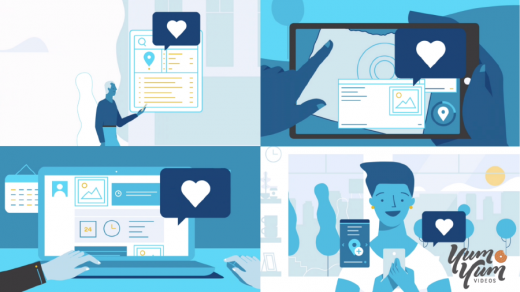Here’s Why You Should Use Video in Your E-Learning Content
Here’s Why You Should Use Video in Your E-Learning Content

Technology has undeniably shaped the tools we use to gain new knowledge. Long gone are the days where learning meant spending hours at the local library or attending long lectures.
In today’s age, both companies and educators work alongside video creators to help deliver information in video format that makes the experience far more engaging and accessible than ever before.
Especially after the shift the pandemic brought, audiences are expecting more than just plain data from their video content. And while this may sound challenging, it’s also an opportunity to think about what the future of education will look like.
In this article, I’m going to guide you through the main reasons why you’ll also want to use video in your e-learning platforms. This post will help you understand not only why audiences prefer this format, but how your teaching objectives will benefit from it as well.

More Content, Less Time
We’ve all become accustomed to short attention spans. Apps like Instagram and Facebook have proven the success of short-form content and bite-sized videos that are easy to digest.
The same goes for people learning online: they seek to get the most information in the shortest amount of time. And there’s no better tool to accomplish both than video content.
Video can condense and convey information more effectively, leading to faster learning. Imagine how long it would take for you to read a product’s manual versus watching a tutorial video with the same info. Time is precious, and you shouldn’t waste it!
Short videos usually focus on explaining a single important concept or setting one main learning objective. This is why the preferred length is between 2 and 6 minutes. Any longer than that and your audience will struggle to maintain focus.
But, if you’re planning a long program for your online course or extended marketing campaign, you can break down your long piece into shorter chapters. For example, the video version of this article could be divided into five short parts that convey single ideas.
Improving User Experience with Storytelling
The key to successful communication lies in storytelling. Ever since the beginning of time, we humans, are drawn to captivating stories that invite us to think, and that leaves us with valuable lessons.
Educational videos that use storytelling as a didactic device can connect with their audiences and guide them through complex and abstract topics that otherwise can be hard to follow.
There’s a reason we as kids learn about ethical concepts through fables that end with a moral. Remember how tales like Pinocchio’s or Cinderella’s taught us not to lie? How could anyone forget such stories!
Creative storytelling can make learning insightful. However, most educational videos take a step even further and incorporate audio narrations, sound effects, and other immersive elements to improve user experience.
And given that no story would be complete without characters.

Using Characters to Exemplify More Clearly
Characters play an essential role in every story and every effective educational video. Generating empathy for a piece’s character helps viewers put themselves in their shoes, and better understand examples and ideas being conveyed.
Think about the most popular films and series out there, like Game of Thrones: each character can act as a symbol for a broader concept. This technique facilitates deep thinking and makes audiences understand situations from different perspectives.
Characters are usually approachable, or at least memorable. This means they should feel like real folk, with all sorts of specific details about their look or personality that your audience can connect to.
Educational videos that use characters are also very demonstration-friendly, making it easier to simulate teachings and processes. By following the doings of a character, audiences learn the practical steps they need to
complete their learning objective.
Appealing to the Viewer’s Feelings to Help Them Retain Information
When you have a story with characters, there’s bound to be emotions. Storytelling is all about making audiences feel what the characters are feeling and make them feel invested in the outcome.
Emotion plays a huge role in our memory. Our feelings can transform mundane events into lasting memories. Our minds are filled with past experiences attached to specific feelings like laughter, crying, surprises, scares.
And when it comes to educational videos, even just the tiniest laugh will do! By making audiences feel something, your teaching will have a lasting effect on them.
A kind-of-funny educational video will lead to a more relaxing learning experience, which also improves information retention. Heartful and emotional stories make audiences focus on what’s being told, freeing them of distraction and capturing their attention.

Accommodating a Variety of Learning Styles
Learning comes in all sorts of shapes and colors. Some people like to read; others prefer data-driven infographics or extended audio lessons or podcasts. The great thing about video content is that it gives you room to provide them all.
As I mentioned at the beginning of this post, technology has allowed the video to become a format both scalable and accessible. As a result, everyone can watch videos on their mobile devices whenever and however they feel like it.
Video can be integrated into virtual classrooms, employee training programs; you name it! However, many people also prefer to micro learn, that is, to learn on the go while on their morning commute or right before going to bed. Short educational videos are the perfect format just for that.
And lastly, videos are easy to share with friends and colleagues on social media or via e-mail. If your piece is informative and interesting, your audience will pass it on and spread your teachings all arouIsn’tsn’t that what is all about?
Parting Thoughts
Learning new things can be both an exciting and challenging idea for most people. We’ve all suffered through a boring lesson, and we know that a lousy class can negatively influence the way we think about education.
So, if you want your e-learning content to have a good and lasting impact on your audience, then the video should be your go-to format.
Inner Article Images: provided by the author; thank you!
Top Image Credit: tima miroshnichenko; pexels; thank you!
The post Here’s Why You Should Use Video in Your E-Learning Content appeared first on ReadWrite.
(94)


